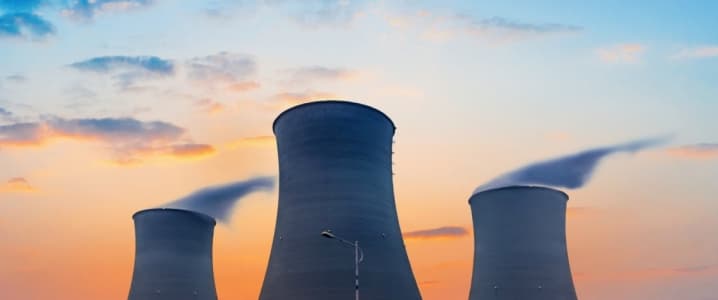Constructing a nuclear power plant is investment and time intensive. Total costs are sky high and timetables between project proposal and actual construction and operation are unpredictable. Two cases in point—UK’s Hinkley Point C project is currently being delayed eight years after the initial target and faces huge cost overruns, and the bankruptcy of a contractor that led to the scrapping of a South Carolina nuclear project.
According to a nuclear fuel expert who has worked on developing nuclear gas turbines, some 80 percent of the construction costs for nuclear power projects where nuclear fission is used to heat steam plants is spent on the technology and facilities outside of the so-called nuclear island, the one that contains the nuclear reactor.
Nuclear plants produce electricity by boiling water into steam, and this steam then turns turbines to produce electricity.
There are technologies that have been studied and developed for decades, and some of them could be used to make the cheaper simple-cycle gas turbines work for nuclear projects, Rod Adams, whose now-defunct firm Adams Atomic Engines used to work on nuclear gas turbines in 1993-2010, argues in an article in Forbes.
The simple cycle gas turbines, also known as Brayton cycle machines, are less efficient than the combined cycle, but they are cheaper to build and operate than steam turbines, and are very flexible in meeting peak demand because they can be started up in minutes. They are not designed to be operated all the time, so their cost is low enough to justify idleness. Simple cycle also does not change the phase of the ‘source material’—it’s gas in all cycles. Related: U.S. Taps Strategic Petroleum Reserve After Hurricane Harvey
However, not a single nuclear project that adapts gas turbines has seen commercial deployment. The maximum temperatures available can’t power a Brayton cycle machine. Therefore, high temperature gas-cooled reactors could be used—and this is a technology that has been studied and developed for decades, Adams says in his article. Two possible developments could make those high temperature gas-cooled reactors (HTGR) achieve really high temperatures of over 1,000 degrees Celsius. These are the Triso particle fuel and the use of nitrogen to cool the reactor instead of helium as nuclear scientists have been largely assuming, Mr. Adams argues.
The Triso particle fuel is not a new invention, it has been around for decades, and continues to be tested. For example, the Idaho National Laboratory (INL) has been doing R&D on fuel development and aims to fabricate Tristructural Isotropic (TRISO) fuels for use in HTGR.
The U.S. Department of Energy (DOE) has reported advances in advanced gas reactor technology using Triso particle fuel.
In June, the DOE picked 85 projects that it will fund with US$67 million to help advance innovative nuclear technologies. Since 2009, the Energy Department’s Office of Nuclear Energy has awarded around US$472 million to 103 U.S. colleges and universities to fund advanced nuclear technology research.
According to the Nuclear Energy Institute (NEI), a total of 99 nuclear reactors currently supply around 20 percent of the U.S. electricity and approximately two-thirds of the nation’s carbon-free electricity. Related: Iraq’s Solution To Lower For Longer Oil Prices
According to NEI’s white paper from November 2016, goals for advanced technologies include demonstrating two or more advanced non-light water reactors by 2025, and ensuring two or more advanced non-light water reactor designs are commercially available (i.e., ready to build) in the U.S. by 2030.
Over the past few years the electricity generation landscape in the U.S. has dramatically changed, the NEI said, pointing to the low-cost shale gas, continuous improvement of cost and performance of wind, solar, and electricity storage, and the traditional business model of large central-station power plants adjusting to distributed generation.
According to the EIA’s 2017 Annual Energy Outlook reference case, the share of nuclear in the U.S. electricity generation mix would drop from 20 percent in 2016 to 11 percent in 2050, as more nuclear capacity is retired than built, and as other fuels such as natural gas and renewables gain market share. In 2050, natural gas will lead the net electricity generation by fuel, followed by renewables and coal, with nuclear at the fourth place. Sometime around 2020, the share of renewables is expected to outstrip nuclear, according to the EIA.
In order for nuclear to overcome current challenges, it really needs a major--and more importantly economically viable--breakthrough in development.
By Tsvetana Paraskova for Oilprice.com
More Top Reads From Oilprice.com:
- Are Libyan Oil Production Gains History?
- Looming Gas Shortage: “Imports Can’t Make Up For This”
- How Long Can U.S. Refineries Remain Offline?


















